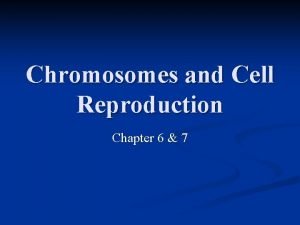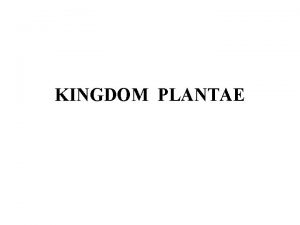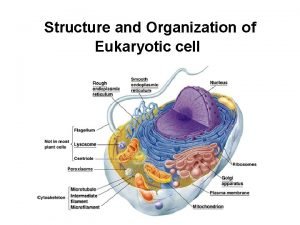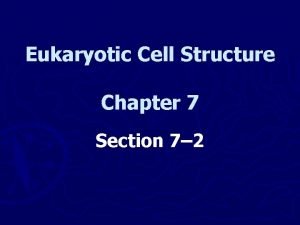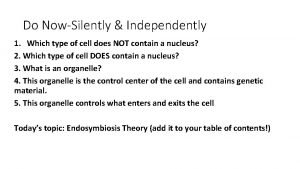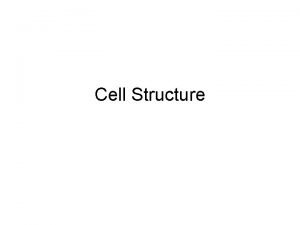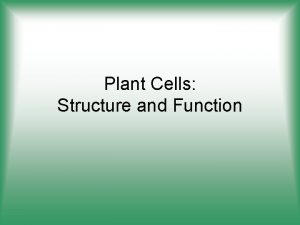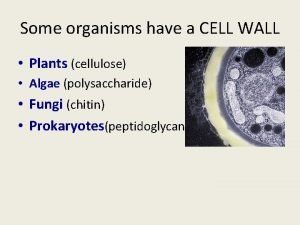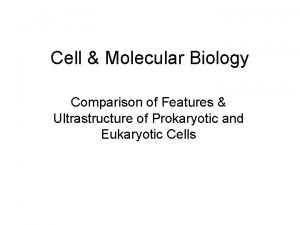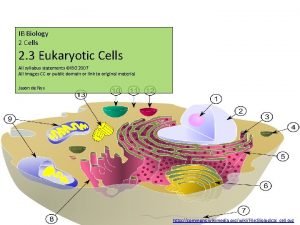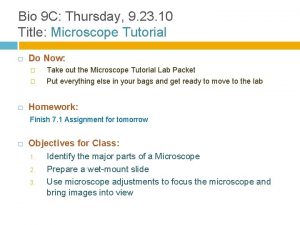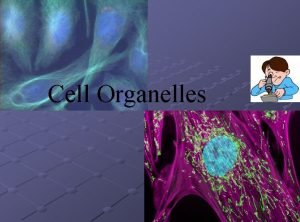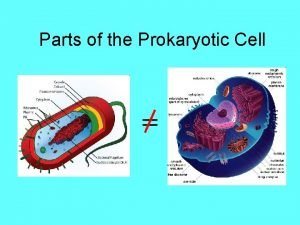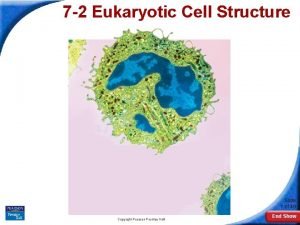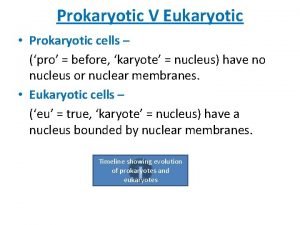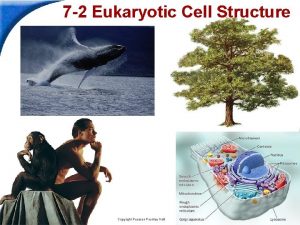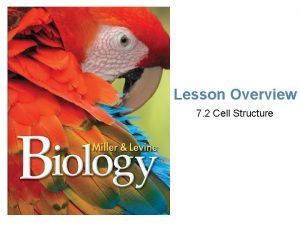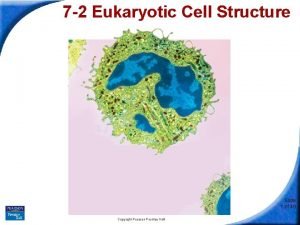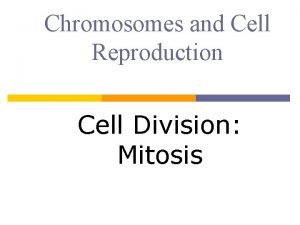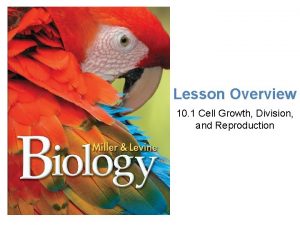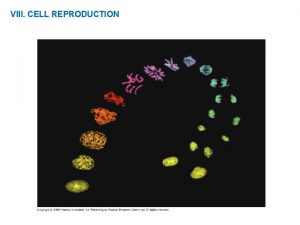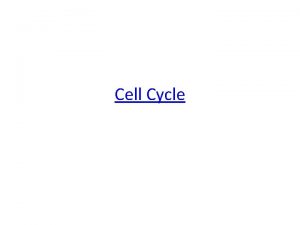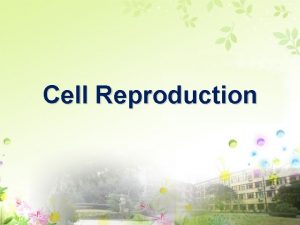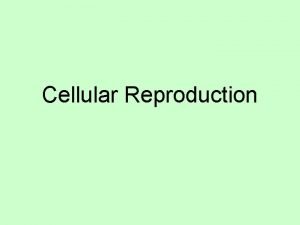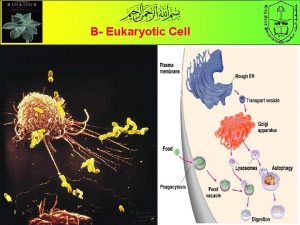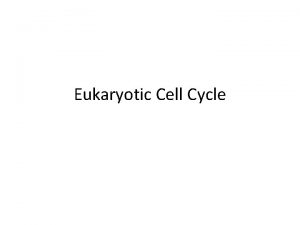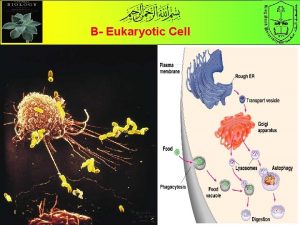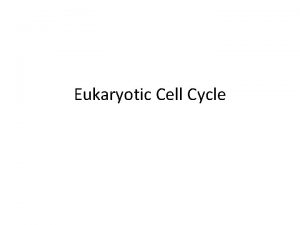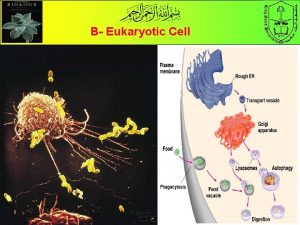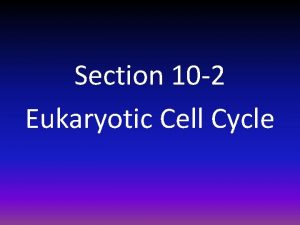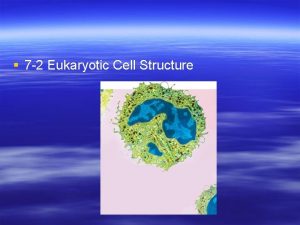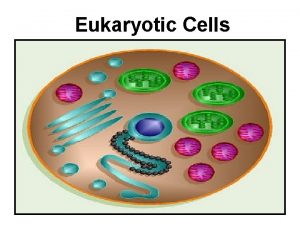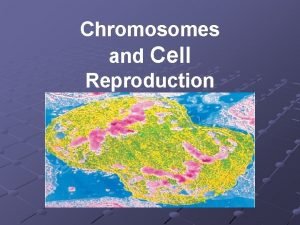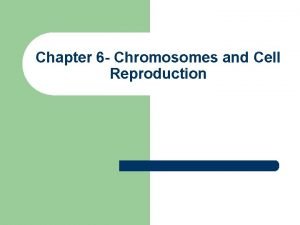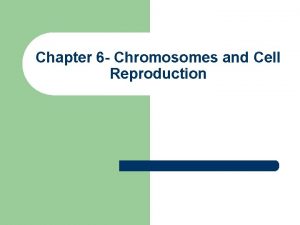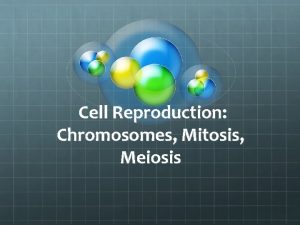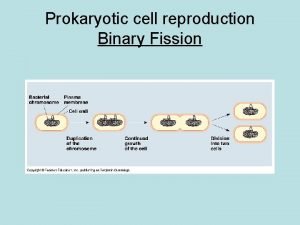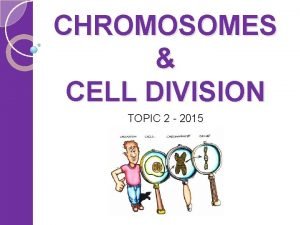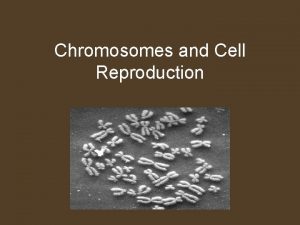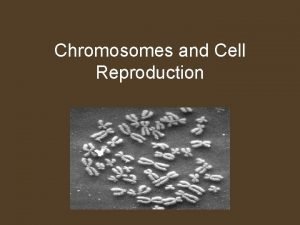Cell Reproduction Chromosomes 1 What are eukaryotic chromosomes




































- Slides: 36

Cell Reproduction

Chromosomes 1. What are eukaryotic chromosomes composed of? DNA and proteins. 2. What are the chromatids and centromeres? Chromatid – each half of the chromosome. Centromere – the constricted area of each chromatid.

3. What are the differences between eukaryotic and prokaryotic chromosomes? Eukaryotic: • Chromosomes are inside the nucleus • Chromosomes are more complex • There are typically many chromosomes Prokaryotic: • Chromosomes are attached to the inside of the cell membrane • Chromosomes are simpler • Most prokaryotes have a single chromosome

4. What chromosome types do humans and animals have? Either sex chromosomes or autosomes. 5. What is the purpose of a sex chromosome? They determine the sex of an organism and carry genes. 6. What is the purpose of an autosome? They carry genetic information.

7. How many human chromosomes are there? 46: 2 sex chromosomes and 44 autosomes 8. What are the sex chromosomes called? X and Y chromosomes. 9. What are homologous chromosomes? The two copies of each autosome (22 pairs of homologues).

10. What sex chromosomes are found in males and females? XY = male, XX = female 11. What is a picture of an individual’s chromosomes called? A karyotype.

12. What’s the difference between diploid and haploid cells? Diploid – 2 n - cell has two sets of chromosomes (all cells other than sex cells). Haploid – 1 n - cell has only one set of chromosomes (sex cells - sperm and egg cells).

How Are We Doing? ? ? Chromosomes that are copies of one another are _____. Homologous OR Identical OR Both Match the following: 1. one set of chromosomes a. diploid 2. XY or XX chromosomes b. chromatid 3. half of the chromosome c. haploid 4. non-sex chromosome d. centromere 5. two sets of chromosomes e. sex chromosomes 6. center of the chromosome f. autosome What are two differences between eukaryotic and prokaryotic chromosomes?

13. What is binary fission? The division of a prokaryotic cell into two offspring cells. 14. What are the 3 stages of binary fission? 1. The chromosome makes a copy of itself, resulting in two identical chromosomes. 2. The cell grows until it is twice the original size. 3. A cell wall forms between the two chromosomes and the cells split. Cell Division

15. What two types of cell division exist in eukaryotes? Mitosis & Meiosis 16. What are the results of mitosis? New cells with genetic material that is identical to that of the original cell.

17. What is the cell cycle? The repeating set of events that make up the life of a cell. 18. What are the phases of the cell cycle? 1. Interphase 2. Mitosis 3. Cytokinesis

How Are We Doing? ? ? What is the correct order of the three phases of the cell cycle? Which of the following are types of cell division? a. meiosis b. binary fission c. mitosis d. a-c Prokaryotes use _____ for cell reproduction, while eukaryotes use ____.

18. Interphase – the time between cell divisions 19. What occurs in the three parts of Interphase? 1. G 1 phase – offspring cells grow to mature size. 2. S phase – the cell’s DNA is copied. 3. G 2 phase – the cell prepares for division. 20. Do all cells divide? No. Those that don’t are in G 0(zero) phase.

21. Mitosis – (M phase) – the nucleus divides. 22. What are the phases of mitosis? a. Stretch (fibers), Coil (DNA), Break (nucleus) b. Line up (chromo) c. Separate (chomo) d. Form (nucleus), break up (fibers), uncoil (chromo)

Prophase 23. What occurs during prophase? • DNA shortens and coils into rod-shaped chromosomes • Chromatids stay connected to one another at the centromere • Nuclear membrane breaks down • Centrosomes appear and move toward opposite poles of the cell • Spindle fibers appear coming from the centrosomes and create the mitotic spindle • Polar fibers extend across the dividing cell from centrosome to centrosome

Prophase

b. Metaphase 24. What occurs during metaphase? • Chromosomes move to the center of the dividing cell • Chromosomes are held in place by the spindle fibers

How Are We Doing? ? ? The G 0, G 1, S & G 2 phases are which part of the cell cycle? Interphase OR Prophase OR Metaphase Match the following: 1. chromosomes move to center 2. cell’s DNA is copied 3. DNA coils into chromosomes a. Interphase b. Prophase c. Metaphase What are the four phases of Mitosis?

c. Anaphase 25. What occurs during anaphase? • The chromatids of each chromosome separate at the centromere and slowly move, centromere first, toward opposite poles • When the chromatids separate, they are considered individual chromosomes

d. Telophase 26. What occurs during telophase? • The spindle fibers disassemble • The chromosomes return to a less tightly coiled state • The nuclear envelope and nucleolus begin to form

3. Cytokinesis – during telophase, the cytoplasm of the cell divides. 27. What happens during cytokinesis in animal cells? • Cytokinesis begins with a pinching inward of the cell membrane in between the cells two poles • A cleavage furrow forms – the area that pinches in and eventually separates • The cleavage furrow pinches the cell into two cells

28. What happens during cytokinesis in plant cells? • Vesicles formed by the Golgi apparatus fuse at the midline of the dividing cell • The fusion forms a membrane bound cell wall called the cell plate • The cell plate separates into two cells

How Are We Doing? ? ? Cytokinesis is part of what phase? Anaphase OR Telophase Match the following: 1. nuclear envelope forms 2. membrane pinches inward 3. chromatids separate a. Anaphase b. Telophase c. Cytokinesis

Meiosis 29. What are the results of meiosis? It reduces the chromosome number by half in new cells. 30. How does meiosis produce half the chromosome number? There are two cell divisions (meiosis I and meiosis II).

31. What are the phases of meiosis I and II called? • Prophase I & II • Metaphase I & II • Anaphase I & II • Telophase I & II 32. Do all cells go through meiosis? No, start with diploid cell, but make sex cells.

Prophase I 33. What occurs in Prophase I? • DNA coils tightly into chromosomes • Spindle fibers appear • Nucleus and nucleolus disassemble • Homologous chromosomes pair up, called synapsis • The chromatids of homologous chromosomes twist-around one another (cross-over) Crossing-over

34. What occurs during crossing over? Genetic material is exchanged between maternal and paternal chromosomes. 35. What is genetic recombination? Crossing-over produces a new mixture of genetic material.

How Are We Doing? ? ? How do the chromosomes differ in meiosis and mitosis in terms of how they line up? What is it called when chromosomes twist around one another exchanging genetic information? What are three characteristics of Prophase I?

36. What occurs in Metaphase I? • The homologous pairs (tetrads) line up randomly • Spindle fibers attach to the centromeres of the chromosomes What occurs in Anaphase I? • Homologous chromosomes move to opposite poles • The random separation of the homologous chromosomes is called independent assortment 37. What is independent assortment? A random separation of maternal and paternal chromosomes (genetic variation).

Telophase I 38. What happens in Telophase I? • The chromosomes reach the opposite ends of the cell • Cytokinesis begins

39. What are characteristics of the cells resulting from meiosis I? • The chromosome number is haploid. • Each cell contains one chromosome from each original homologous pair 40. When does meiosis II begin? • Sometimes after the nuclear membrane forms • Sometimes immediately after meiosis I

How Are We Doing? ? ? The random separation of maternal and paternal chromosomes is ________. Crossing Over OR Independent Assortment Match the following: 1. homologous pairs line up 2. chromosomes move to poles 3. DNA coils into chromosomes 4. cytokinesis begins a. Prophase I b. Metaphase I c. Anaphase I d. Telophase I

41. What occurs during prophase II? • Spindle fibers form • Chromosomes move towards the middle 42. occurs during metaphase II? • Chromosomes move to the middle of the cell • Chromosomes face opposite poles of the cell

43. What occurs during anaphase II? The chromatids separate and move toward opposite poles of the cell. 44. What occurs during telophase II? • Nuclear membrane forms around chromosomes in each of the four cells • Cytokinesis II occurs

45. What animal cells are formed using meiosis? Reproductive cells (cells in the testes and ovaries in humans). 46. What are gametes? Haploid reproductive cells produced by meiosis. 47. What are male and female gametes called? Male = sperm cells or spermatazoa or spermatids. Female = egg cells or ova. 48. What are spermatogenesis and oogenesis? Spermatogenesis – production of mature sperm cells. Oogenesis – production of mature egg cells.

How Are We Doing? ? ? What kind of cells use meiosis for cellular division? Match the following: 1. chromatids separate 2. nuclear membrane forms 3. spindle fibers form 4. Chromosomes line-up at middle a. Prophase II b. Metaphase II c. Anaphase II d. Telophase II Male gametes are called ______, while female gametes are called ______.
 Insidan region jh
Insidan region jh Chapter 6 chromosomes and cell reproduction
Chapter 6 chromosomes and cell reproduction Prokaryotic and eukaryotic cells
Prokaryotic and eukaryotic cells Life
Life Eukaryotic cell animal cell
Eukaryotic cell animal cell Site:slidetodoc.com
Site:slidetodoc.com Eukaryota
Eukaryota Monera procariota
Monera procariota Asexual reproduction vs sexual reproduction venn diagram
Asexual reproduction vs sexual reproduction venn diagram Sexual reproduction vs asexual reproduction venn diagram
Sexual reproduction vs asexual reproduction venn diagram Sexual reproduction and asexual reproduction
Sexual reproduction and asexual reproduction Eukaryotic cell
Eukaryotic cell Fungi locomotion present or absent
Fungi locomotion present or absent Eukaryotic cell structure
Eukaryotic cell structure Section 7-2 eukaryotic cell structure
Section 7-2 eukaryotic cell structure Eukaryotic cell questions
Eukaryotic cell questions Eukaryotic cell organisation
Eukaryotic cell organisation Eukaryotic plant
Eukaryotic plant Are cell walls prokaryotic or eukaryotic
Are cell walls prokaryotic or eukaryotic Typical eukaryotic cell
Typical eukaryotic cell Ib biology eukaryotic cell diagram
Ib biology eukaryotic cell diagram Cell organelle
Cell organelle Differences between prokaryotic and eukaryotic
Differences between prokaryotic and eukaryotic Parts of a prokaryotic cell
Parts of a prokaryotic cell Eukaryotic cell
Eukaryotic cell Section 7-2 eukaryotic cell structure
Section 7-2 eukaryotic cell structure Staphylococcus aureus prokaryotic or eukaryotic
Staphylococcus aureus prokaryotic or eukaryotic Pro karyote
Pro karyote 7-2 eukaryotic cell structure
7-2 eukaryotic cell structure Eukaryotic cell structure
Eukaryotic cell structure Do seedless plants have cell walls made of cellulose
Do seedless plants have cell walls made of cellulose 7-2 eukaryotic cell structure
7-2 eukaryotic cell structure Cell reproduction
Cell reproduction Cell growth division and reproduction
Cell growth division and reproduction Mitosis sexual reproduction
Mitosis sexual reproduction Cell of reproduction
Cell of reproduction Cell reproduction
Cell reproduction

